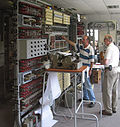Lorenz cipher

The Lorenz cipher was a class of German rotor stream cipher machines used by the German Army during World War II. It was mostly used for messages among headquarters. This machine and its messages were eventually worked out by the team at Bletchley Park during World War II.
British cryptanalysts (codebreakers) worked out its logical structure three years before they saw the machine.[1][2]
Lorenz Cipher Media
A rebuilt British Tunny at The National Museum of Computing, Bletchley Park. It emulated the functions of the Lorenz SZ40/42, producing printed cleartext from ciphertext input.
A team led by Tony Sale (right) reconstructed a Colossus (Mark II) at Bletchley Park. Here, in 2006, Sale supervises the breaking of an enciphered message with the completed machine.
References
- ↑ Hinsley F.H. & Stripp, Alan eds. 1992, Codebreakers: The inside story of Bletchley Park. Oxford: Oxford University Press. ISBN 978-0-19-280132-6
- ↑ Copeland, B. Jack, ed 2006. Colossus: the secrets of Bletchley Park's codebreaking computers. Oxford: Oxford University Press. ISBN 978-0-19-284055-4
- ↑ Good, Michie & Timms 1945, 1 Introduction: 11 German Tunny, 11B The Tunny Cipher Machine, p. 6.




